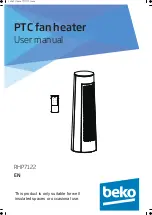
LAARS Heating Systems
Page 12
of hot water from the heater when the filter pump
stops running.
See Figure 6 for proper connection of the
Pennant heater to the pool loop.
4.2 Automatic Chlorinators
A concentration of chlorine in the heater can be
very destructive; therefore the following rules about
the installation and operation of such devices must be
followed:
1.
The chlorinator should be installed so it introduces
the gas or solution downstream of the heater.
2.
The chlorinator should be wired so it cannot
operate unless the filter pump is operating.
3.
The chlorinator should be provided with an anti-
siphon device so that the draining of the piping
after the pump shuts off will not siphon chlorine
solution into the heater.
4.
When the operation of a chlorinator is such that
it must be installed in the pump suction, or some
other place where the chlorine solution flows
through the heater, corrosion of the heater can
occur. Excessive concentrations of chlorine
resulting from improper adjustment or
chlorinator equipment failure are responsible for
this corrosion. The heater warranty does not
cover the resulting damage to the heat exchanger.
4.3 Sensor Locations
Two sensors must be installed in the pool loop,
as shown in Figure 5. The inlet sensor for the
temperature control must be installed in the pool loop
Figure 6. Pool Heater Piping.
The Pennant Pool Heater is shipped with a field-installed mixing system, and must be piped in primary-
secondary style, as shown. A remote pool temperature sensor and remote pool temperature high limit
are wired to the Pennant, to be mounted in the pool water loop, as shown.
within 12” (30 cm) of the inlet to the heater. This
sensor is
not
installed in a well. For sensitivity, it must
be installed in direct contact with the pool water flow.
The second sensor, the high limit sensor, must be
installed in the pool loop within 12” (30 cm)
downstream of the heater outlet. This sensor is a
capillary and bulb. It shall be used with the immersion
well that is provided.
SECTION 5.
Electrical Connections
WARNING
The appliance must be electrically grounded in
accordance with the requirements of the authority
having jurisdiction or, in the absence of such
requirements, with the latest edition of the National
Electrical Code, ANSI/NFPA 70, in the U.S. and
with latest edition of CSA C22.1 Canadian Electrical
Code, Part 1, in Canada. Do not rely on the gas or
water piping to ground the metal parts of the boiler.
Plastic pipe or dielectric unions may isolate the
boiler electrically. Service and maintenance
personnel, who work on or around the boiler, may
be standing on wet floors and could be electrocuted
by an ungrounded boiler.
Single pole switches, including those of safety
controls and protective devices must not be wired in a
grounded line.
All electrical connections are made in the field
Содержание Pennant PNCP 500
Страница 28: ...LAARS Heating Systems Page 28 Figure 9 Sheet Metal Components...
Страница 29: ...Pennant Pool Heater Page 29 Figure 10 Internal Components...
Страница 30: ...LAARS Heating Systems Page 30 Figure 11 Heat Exchanger Components A See pump chart below for pump numbers...
Страница 31: ...Pennant Pool Heater Page 31 Figure 12 Pennant 500 1000 Ladder Diagram SECTION 10 Wiring Diagrams...
Страница 32: ...LAARS Heating Systems Page 32 Figure 13 Pennant 1250 2000 Ladder Diagram...
Страница 33: ...Pennant Pool Heater Page 33 Figure 14 Pennant 500 1000 Wiring Schematic...
Страница 34: ...LAARS Heating Systems Page 34 Figure 15 Pennant 1250 2000 Wiring Schematic...
Страница 35: ...Pennant Pool Heater Page 35 Figure 16 Field Wiring PNCP 500 1000...













































